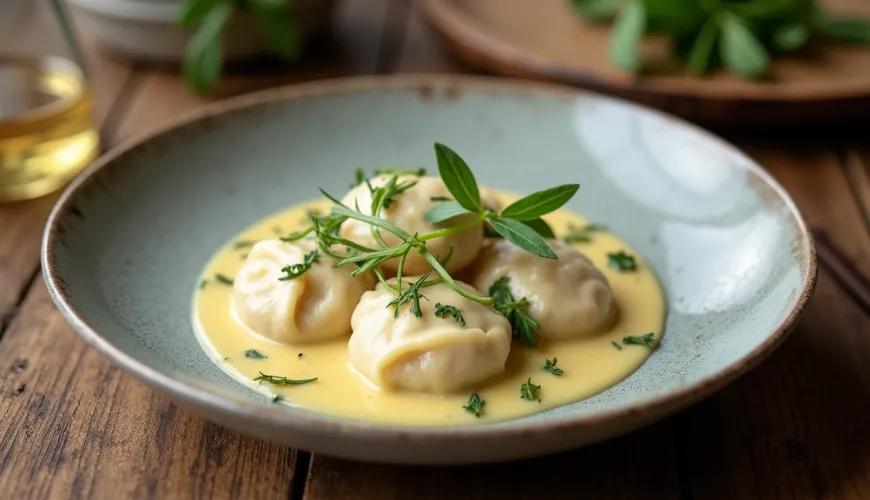
Discover Fake Sirloin and Learn to Prepare It at Home

Fake Svíčková - A Tasty Alternative with Tradition and Respect for Ingredients
Czech cuisine is renowned for its distinct taste, honesty, and deep relationship with meat. Among its iconic dishes is undoubtedly svíčková na smetaně – a celebratory, warm, and beloved meal across generations. But what to do when real svíčková, that is, beef tenderloin, is not at hand, or simply unaffordable? The answer is fake svíčková, a dish that embodies all the nostalgic flavors while reflecting a modern approach to cooking – practicality, sustainability, and accessibility.
What is fake svíčková and how does it differ from the real one?
Fake svíčková doesn’t have much in common with the real tenderloin part of beef – except for the name and the resulting taste of the dish. This stems from the fact that it uses a cheaper and more accessible part of beef, usually the front shank, neck, or round shoulder. While these parts are not as tender as the real tenderloin, with the right preparation, they can offer a fullness of flavor, juiciness, and structure that is key to svíčková.
Moreover, these parts of meat respond excellently to slow braising, making them perfect for oven preparation. If someone asks: What is fake svíčková good for? – the answer is simple. For everything that the real svíčková can handle. And sometimes even more.
Fake svíčková in the oven
If Czech cuisine has something in common with the concept of slow food, it is precisely the patient braising of meat and vegetables in the oven. The recipe for fake svíčková assumes that the meat needs time to soften, release its juices, and through connection with root vegetables, create the base for a typical, creamy sauce.
Experienced cooks often first sear the meat in a pan, then transfer it to a roasting pan along with carrots, celery, parsley, and onion, add spices like allspice, bay leaf, and whole pepper, pour in broth or water, and put it to bake in the oven. Within two to three hours, a broth full of flavor emerges, the meat nearly falls apart, and the vegetables beautifully caramelize. Then it’s just a matter of blending the vegetables, adding cream, and possibly seasoning with a little sugar, vinegar, or lemon.
Preparing fake svíčková in the oven is not only easier to control, but also more ecological – especially if you use the oven for a larger amount of food at once or bake other dishes simultaneously. Additionally, this minimizes the need for seasonings – flavor develops naturally through long, slow cooking.
Fake svíčková recipe
There are many variations of the fake svíčková recipe, but at its core, it follows a proven method. Here is an example of one of the traditional yet simple recipes:
Ingredients:
- 1–1.5 kg of front beef (e.g., fake tenderloin, round shoulder, neck)
- 3 carrots, 2 parsleys, 1/2 celery
- 2 onions
- 2–3 tablespoons of oil or clarified butter
- 5 allspice berries, 5 peppercorns, 2 bay leaves
- 1 teaspoon of salt, sugar, lemon or vinegar to taste
- 250 ml of whipping cream
- 500 ml of broth or water
Instructions:
- Salt the meat and sear it on all sides in hot fat. Remove and set aside.
- In the remaining fat, sauté the roughly chopped vegetables and onions until golden brown. Add the spices, and briefly roast.
- Place the meat back into the roasting pan, pour in the broth, cover, and bake at 160 °C for approximately 2.5 hours – until the meat is tender.
- Remove the meat, strain or blend the sauce, add cream, and season to taste. Serve with bread dumplings.
Fake svíčková as a sustainable choice
In times when more people are considering the origins of food, the impact of livestock production on the environment, and the cost of meat, fake svíčková represents a rational way to combine tradition with consideration. Using cheaper cuts of meat isn't just about saving money – it’s a way to prevent waste and give a chance to ingredients that historically found their way to the Czech table precisely for their practicality.
A common question is: Is fake svíčková of lower quality? Definitely not. If the meat is properly prepared, it often surprises even those accustomed to luxury svíčková. Moreover, this way makes better use of the entire animal, which is not only economical but also ethically more responsible.
When fake svíčková becomes a family favorite
The Novák family from Pardubice has passed the fake svíčková recipe down through generations. "My grandmother always made it from beef shank because we simply couldn't afford tenderloin," recalls Mrs. Jana, adding: "Today, I tried it with organic meat from a farmer's market, and the kids were asking for seconds. I told them it’s fake svíčková, and my youngest daughter just laughed: 'Why fake when it tastes completely real?'" This story vividly illustrates that the quality of a dish doesn’t lie in the grandiosity of its name, but in the way it’s prepared and the love with which it is served.
What can you do with fake svíčková
If the fake svíčková recipe caught your interest, you might be pleased to know that it is very versatile and adaptable. It can be prepared without cream as a lighter version, perhaps for children or those with allergies. It can also be enriched with mushrooms, smoked paprika, or served with roasted vegetables or boiled potatoes instead of the traditional dumplings. For a plant-based version, the meat can be replaced with jackfruit or roasted celery – resulting in a genuine vegan svíčková.
From a meat processing perspective, fake svíčková is also ideal for freezing – it is often prepared in larger quantities and part of the dish is set aside for later. When reheated, the sauce maintains its thickness and flavor, making it an ideal meal even for a busy workweek.
"When you cook with care, even fake svíčková tastes like the real thing," they say in culinary circles. And there’s definitely some truth to it.
In today's world, where more people are turning back to home cooking, fake svíčková is a beautiful reminder that authenticity doesn’t lie in expensive ingredients but in respect for tradition and taste. And that’s why this dish deserves its place not only in cookbooks but also on the tables of modern households seeking a balance between flavor, health, and a responsible approach to food.

